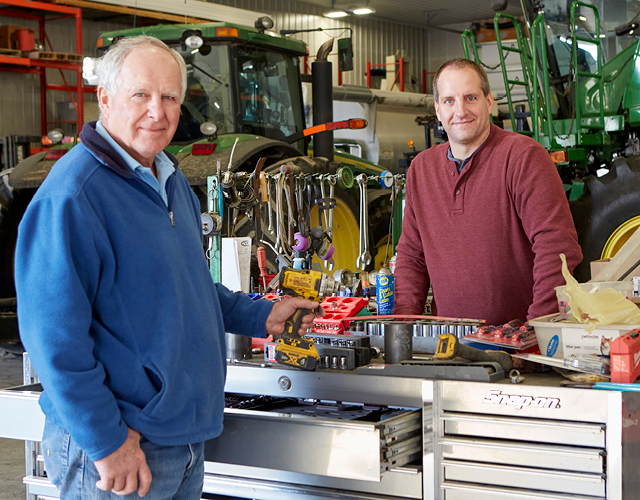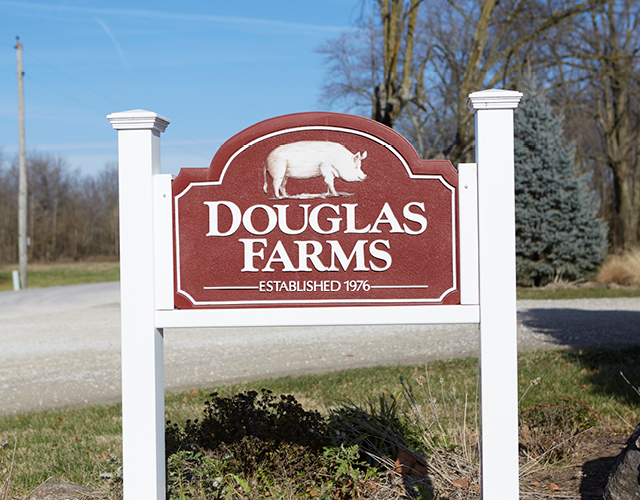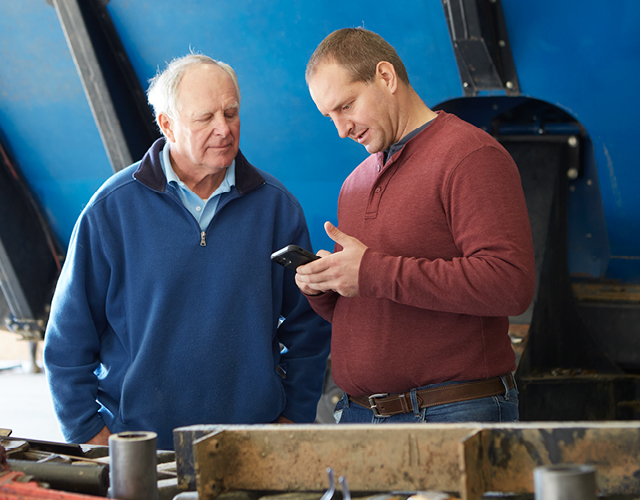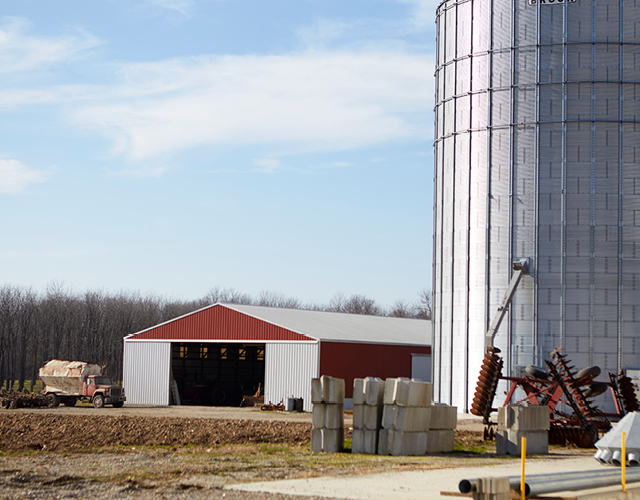Purposeful Transition Guides Indiana Father-Son Team

Take a look around Douglas Farms and you know this operation is focused on the future. A cutting-edge grain storage system shadows a picturesque and functional shop and office. Several specialty row crops grow in surrounding fields. Nearby, 3-week-old pigs are being fed to market weight through an innovative partnership.
Aesthetics aside, the reason this farm will grow forward is the focus of its leaders, Jim, 66, and James, 33. For years, the father-and-son team never dreamed they would be partners in the farm. But through proactive planning, strong communication and an eye on finances, the two have a solid framework in place.
Hog-and-Crop Model
A fourth-generation operation based in Flat Rock, Ind., Douglas Farms included 120 acres when Jim returned home after college. Jim bought his dad’s equipment and the homestead. He grew his acreage base and started a farrow-to-finish hog operation to diversify.
That hog-and-crop model supported the family for decades, which included his wife, Kay, and their five children: Julie, Lora, Katie, James and Leann. The Douglas children grew up and left the farm.

James headed to Purdue University and graduated in 2010 with a bachelor’s degree in building construction management. After working for five years in that field, the flat, rich soil of central Indiana started pulling him home.
“If I was going to try farming, it was the time,” James says. “If I didn’t like it, I’d just go back to construction. But once I moved back, I haven’t looked back.”
After James’ return, the family knew they should start the succession planning process. Jim’s father had set a good example of how to welcome the next generation home and set them up for success. Five years into the process, Jim and James know they still have a long road and lots of issues to work out in the years ahead. Yet, they have learned many valuable lessons during the journey.
Start with goals and a timeline.
To start the process, Jim and James met with their family attorney. They talked through the pros and cons of forming an official partnership or building their operations collaboratively.
Jim’s original goal was to retire by age 70. Originally, they decided against jointly owning assets. But this year they formed a limited liability company (LLC), which is jointly owned by the two. Owned land and equipment will be rented by the LLC. This new arrangement simplifies inventory and billing and will help Jim phase out of ownership.
Allow heirs to build equity.
When James returned, he knew his father didn’t plan to just hand over acres or assets. The two decided they would share labor and have James slowly buy assets to let Jim phase out of ownership and risk.
“One of the first things I did was build a hog barn, which has provided a good income stream and equity,” James says. “The big advantages I’ve had are having a good base of operations and my dad shouldered the bulk of the equipment costs as I started out. However, as planned, I’m beginning to shoulder more of that burden at a pace that meets both of our goals and timelines.”
Don’t make heirs pay twice.
Jim had a clear goal with his succession plan: Don't make the younger generation pay for assets twice.
“They work here and through their labor they are helping you run the operation and pay for it,” he says. “If you don’t plan, when you phase out you appraise everything and the child working here has to pay his siblings for it, and really they already helped pay for it with labor.”
When Jim started farming, his dad sold him the family homestead. “On the rest of the physical facilities, we froze the value,” he explains. “Then when he died, we paid that money into his estate. Along the way, we were free to add on to any of our buildings without the thought we’d have to split assets after he died. Plus, I knew the price I was going to pay.”
Transfer responsibility and knowledge.
As the swine industry evolved, Jim decided to transition from farrow-to-finish and partner with the Legan family to form a separate enterprise: D&L Pork. The Legan family delivers weaner pigs, which are finished out on the Douglas farm. This collaboration happened around the same time of James’ return home. It was a natural place for him to step in and take on responsibility.
“If I see mistakes amongst my farming peers, it’s the dad not willing to give up the combine or planter seat,” Jim says. “You have to give younger people some responsibility and let them run with it.”
When farming with adult children, it is important to be open to ideas, delegate meaningful responsibility and share decisions, explains Val Farmer, a clinical psychologist and author who specialized in family relationships during his 30-year career.
“Too many farmers have a top-down style of management that robs their operations of motivation, commitment and ideas that would make for better farming and happier people,” Farmer says.
Through this transition of leadership, decision-making authority and growth, Farmer has a simple reminder: “One doesn’t manage creativity; one manages for creativity.”

Plan for future obstacles.
Jim carefully analyzed how to treat his on-farm and off-farm children fairly. They put their farm ground in a limited liability company to easily transfer ownership.
“Our children all have professional careers,” he says. “You don’t foresee them needing money prematurely before our deaths. But you never know, as medical conditions or divorce throw curveballs. Even after we’re gone, those issues could prevent them from maintaining ownership of land. So, you really need a vehicle for them to cash out.”
Stay focused and revisit the plan.
Jim and James know their succession plan is farm from concrete. They know parts will need revisited and reworked.
“Your life changes and so does your kids’ lives,” Jim says. “When you revisit it five or 10 years later and talk through some of these same questions, their answers may change.”

Take Steps to Release the Farm Reins
Parents should take these steps to create a profitable and supportive transfer of control of a farm, explains Val Farmer, a clinical psychologist and business advisor. He provides this advice.
- Support their desire to be independent. Now is the time to minimize your own role as the lone ranger who did it all.
- Be an appreciative audience for their ideas. How you ask questions is key. Be supportive, not critical or demoralizing.
- Encourage diverse experiences, exposure to new strategies and collaboration with other professionals. Suggest travel and conferences that expand horizons.
- Create a healthy relationship with failure. Your reactions to failure will be the greatest cue as to your children’s willingness to be creative.
- Give appropriate recognition. Join with others in publicizing and sharing the success of your children’s innovations. Take a back seat, or others will assume you are the driving force.

Taxes aren’t the problem when it comes to succession planning. Kids’ future divorces and lack of communication cause even bigger problems says attorney Polly Dobbs. Learn how to protect your assets.








